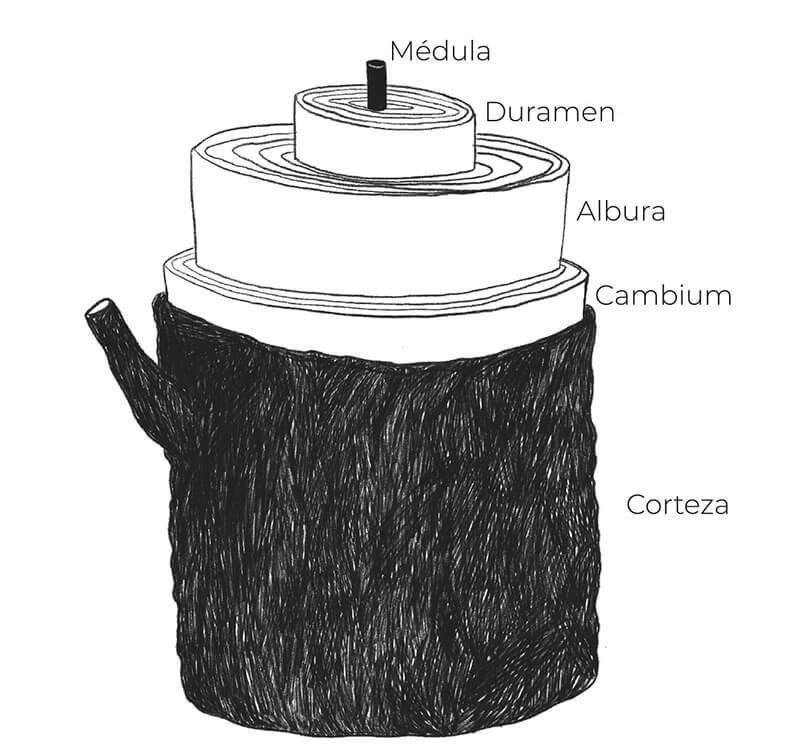In the previous article we looked at the types of wood for spoon carving with hand tools. Now that we know what wood to use, let’s see what part of the log or branch we can carve.
When it comes to carving wooden spoons, understanding the wood grain and how the material deforms is crucial for achieving durable and aesthetically pleasing results. The wood grain, or the tree’s growth pattern, not only defines the final appearance of the carved pieces but also their stability. In this article, we’ll explore how choosing the right cut of wood influences both the design and durability of wooden spoons, as well as the best practices for preventing deformation during the drying process.
The Importance of Wood Grain in Spoon Carving
Wood grain represents the growth lines of the tree and varies depending on the type of cut made. When selecting wood for spoon carving, it’s essential to consider how the grain will affect the final appearance. An attractive grain pattern not only highlights the natural qualities of the wood but also adds character and distinction to the finished piece.
There are two main types of cuts that affect the grain design: radial and tangential cuts. In a radial cut, the upper and lower surfaces are perpendicular to the growth rings, resulting in parallel striped grain patterns. On the other hand, a tangential cut, where the surfaces are tangent to the growth rings, produces patterns of concentric rings or opposing arches, depending on the orientation of the piece.
Choosing the Right Wood for Spoon Carving

Not all parts of the log or branch are equally suitable for carving spoons. Avoiding the pith, the soft and unstable center of the trunk, is crucial as this area tends to deform and crack when drying. The best option is to work with the heartwood (the dense inner part) and the sapwood (the younger, lighter wood surrounding the heartwood).
Avoiding the Pith
The pith should be avoided in spoon carving due to its unstable nature. As the wood dries, the pith shrinks unevenly, which can cause cracks and deformation in the spoon, affecting both its functionality and appearance.
Using the Bark
In some species of wood, the bark can be used as a decorative element on the spoon. However, not all species allow for this type of ornamentation, as the bark may peel or deteriorate over time.
Types of Cuts and How They Affect Wood Deformation
The type of cut chosen when carving spoons determines not only the grain pattern but also the wood’s stability as it dries. Understanding the differences between radial and tangential cuts is key to minimizing deformation and ensuring a long-lasting spoon.
Radial vs. Tangential Cuts
The radial cut is the most stable of the two, as the wood shrinks more uniformly in this orientation. Spoons carved from a radial cut show fewer deformations and tend to retain their original shape better. On the other hand, the tangential cut, while producing more striking grain patterns, is more prone to deformation during drying. The resulting spoons may develop unwanted curves, especially under conditions of rapid or uneven drying.


Deformation Patterns
Wood always shrinks more in the tangential plane of the growth rings and less in the radial plane. This shrinkage process can cause significant deformation in the spoons, especially if the wood is not dried in a controlled manner. To minimize these deformations, it is essential to pay attention to the type of cut and the storage of the wood during drying.

Proper Storage of Green Wood
Proper storage of green wood is one of the most important factors in preventing cracks and deformations in spoons. When wood dries too quickly, internal stresses can cause fissures, affecting the integrity of the piece. To prevent these issues, it’s important to control the drying rate.
Effective methods for storing green wood include wrapping the pieces in plastic, reducing direct sun exposure, and keeping them in a humid environment. These measures help the wood dry more slowly and evenly, reducing the risk of cracks and deformation. Read more about this subject in the article: Storing green wood: How to prevent cracks
Final Tips for Carving Wooden Spoons Without Deformations
To create wooden spoons that maintain their shape and functionality, it is essential to consider the type of cut and how the wood is stored during the drying process. Radial cuts offer the most stability, while tangential cuts, though more susceptible to deformation, can be ideal for those seeking more ornamental grain patterns. Additionally, by properly storing green wood, cracks and other problems that can affect the durability of the final piece can be avoided.
In the following video you can find a detailed explanation of how to select the wood for a spoon within the structure of the trunk: Spoon Carving – Wood orientation
Conclusion
Understanding how wood deforms as it dries and how different cuts affect the grain design is fundamental for artisans who want to carve durable and visually appealing wooden spoons. By carefully choosing which part of the trunk to use and how to cut it, the grain design can be influenced, and deformations minimized, ensuring that the spoons are both functional and beautiful.
If you don’t have access to green wood and want to learn how to carve a spoon, you can purchase our Spoon Carving Tool Kit which includes everything you need to get started.

